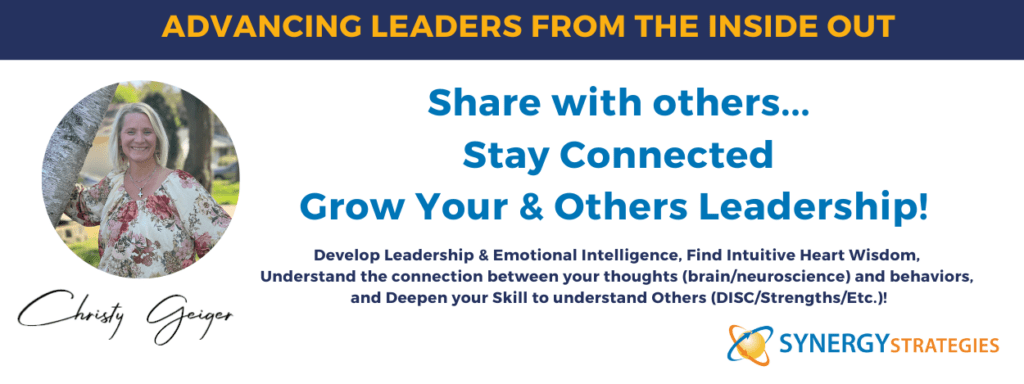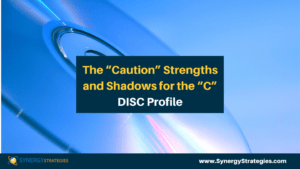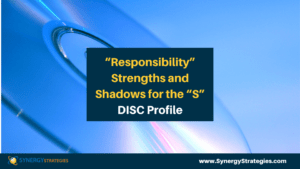In leadership, how you present yourself matters. The way you show up and the energy you give off is called “Executive Presence”. Executive Presence starts first on the inside with how you feel. Second is your impact which is important, but for another post. So first we must be PRESENT and then make sure our presence is EXECUTIVE quality.
5 core skills to help assess and build executive presence
- POSTURE. Physically how are you showing up? Do you slouch, avoid eye contact, or look down, or at your phone? Executive presence shows you are physically engaged. Stand or sit up straight. Lean forward. Make eye contact. Respond with engagement (nod, smile, etc.). Hold energetic space with your calm, joyful, and stable energy.
- VISION & FOCUS. What are you focused on? Do you think more about yourself, your actions, your responsibilities, and the impact things have on you? Executive presence knows what personally needs to be done, but thinks more about the bigger picture, the present and the future, where this current course is leading, and if that is where things need to go. It sees the interconnection between different things while holding the goal. It knows why the goal matters and has awareness of what steps they personally and those around them need to take to achieve the plan and vision. It is not micromanaging how others do their work but asking questions. It is a constant radar to ensure that cumulative actions will take the team in the right direction and achieve the desired results.
- CONFIDENCE & CANDIDNESS. Do you find yourself quietly thinking about things? Do you feel nervous to express your thoughts and ideas related to the big picture? Do you have a lot of self-talk running in your mind, keeping you from fully listening? Do you question what or when to say things? Do you worry about saying too much or coming across the wrong way? Do you feel like when you do talk, you must sell or compete for floor space to be heard? Executive presence works on emotional intelligence. When one talks, the conversation is not about them or their needs, but rather represents the vision and future goals. Executive presence is more focused, committed, and dedicated to taking risks for the sake of best outcomes rather than self-preservation. This is what allows for greater engagement, sharing of thoughts and ideas, and contributing to moving action forward in a mindful, excellent, and thorough way. It creates space for others to share but has a gentle press forward. It is a developed art of communication that improves the more you express yourself, and naturally comes out better when focused on the mission. This is why when you are passionate about something, it is easier for you to just “come out” because you almost can’t help yourself. In executive presence, however, it has this energy of passion and commitment spoken through a lens of the mission over self.
- VISIBLE & ACTIVE. Do you spend a lot of time in your office working on your items? Do you feel like you need to hide to avoid more on your plate? Is your time filled with juggling things and waiting for others to reach out if needed? Do you have an open door so people can pop in as needed, but really you are only partially present because it is an interruption? Executive presence is organized, active, and engaged. It creates space to check in with people and make sure their team is good. It connects with people and sets time aside proactively. It sends nudges and check-ins, not to parent or do thinking for the team, but to say I am here, present, engaged, and care. It shows you know what is important and notice and support those key things staying in priority and motion. It touches base with people to see how they are doing not only on their tasks but as an individual. It is selfless and sees others before their own tasks or self. Due to this, executives do need to create healthy habits for self-care (workout, sleep, person for them to talk to i.e. coach, therapist, etc.) so that they do not burn out. Executives need an outlet to care for themselves like they care for others. As they say, “It is lonely at the top.” Why? Because while you are pouring more into your team, there are no people pouring into you. Executive presence leads to moving things forward by being connected and engaged with the team.
- KNOWLEDGEABLE. Do you feel worried about looking competent and credible? Do you feel like you have to cover yourself or be defensive if something goes wrong? Do you feel behind or riding an old wave of skills and training? Executive presence is constantly learning. Leaders are readers; they are always learning. They are sharpening their skills and have diversified areas they study or intentionally develop. They are knowledgeable not only of their own area but areas that are related. They are networkers and constantly learning from others. They are humble to not be the smartest person in the room but intentionally put themselves in rooms where they can learn from others and be challenged to level up their game. They have a lot to bring to the table but also do not worry about sharing their knowledge. They are focused on moving things forward to achieve the goal but use their knowledge to support creating strong plans, prioritizing, and making strong decisions. Leaders take time to be organized to review what is happening for themselves and others. They are knowledgeable not only about how to execute whatever hard skill competency but also about what is happening with the team, the plan, and the overall “state of the union”. This lens allows them to connect more dots, have a sage perspective, and drive the next steps while catching gaps and identifying blind spots.
Strengthening these five Executive Presence soft skills will help every leader to show up confidently and contribute to making a significant impact in the work you do. These are skills that can be constantly honed and upgraded as the needle is always moving and the art of business and leading teams is continually evolving.






